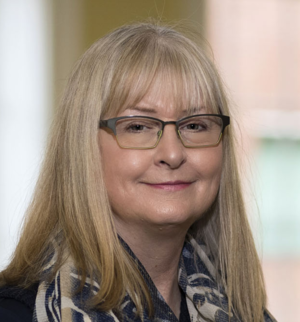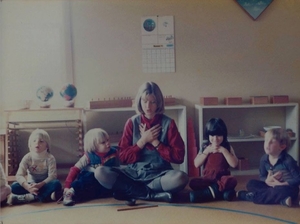Patricia Jennings: Self-care is critical to helping others

We are excited to welcome Dr. Patricia Jennings, M.Ed., Ph.D. to our upcoming Heart-Mind 2018 conference. Dr. Jennings is an internationally recognized leader in the fields of social and emotional learning and mindfulness in education, with a specific emphasis on teacher stress and how it impacts the social and emotional context of the classroom.
An Associate Professor of Education at the Curry School of Education at the University of Virginia, Dr. Jennings led the team that developed CARE for Teachers, a mindfulness-based professional development program shown to significantly improve teacher well-being.
We have asked Patricia to share a few insights on her work on mindfulness and how cultivating self-care is critical in helping others.
DLC: What inspired you to focus your work on mindfulness in education?
I began practicing Zen meditation long before I became a teacher. When I decided to go into the field of education, I was looking for an approach where I could apply my mindfulness practice to my teaching, so I studied Montessori education. For me, each lesson in my classroom was a mindfulness practice. I also taught my students simple calming and focusing practices. However, it wasn’t until I began working as a teacher educator that I realized just how much my mindfulness practice was helping me stay calm in the face of the daily challenges of the classroom.
I spent 15 years supervising student teachers and teaching classroom management. I observed my students attempt to practice time tested ways to respond to student inappropriate behavior, but noticed that their emotional reactivity was interfering with their effectiveness. I became very curious about why teaching is so stressful and why my mindfulness practice was so helpful to me, so I decided to return to graduate school and earned my doctorate in human development, with a focus on stress and coping in adulthood. For the past 14 years I’ve worked to apply this understanding to helping teachers and students manage classroom stress to promote supportive classroom environments that are conducive to student learning.
DLC: How do compassion and mindfulness help people enhance their daily well-being?
 Human beings have a deep need for connection. We need to feel like we have a place in our community and that we can make a valuable contribution that is recognized by others. However, today these needs often go unmet in a fast-paced world where there is high mobility and social fragmentation. Educators are recognizing that this sense of connection, or relational trust and safety is key to creating a learning environment where students flourish.
Human beings have a deep need for connection. We need to feel like we have a place in our community and that we can make a valuable contribution that is recognized by others. However, today these needs often go unmet in a fast-paced world where there is high mobility and social fragmentation. Educators are recognizing that this sense of connection, or relational trust and safety is key to creating a learning environment where students flourish.
However, demands of the classroom such as high stakes testing, greater numbers of students coming to school unprepared and with symptoms of trauma exposure create stress that can interfere with our ability to cultivate a caring and supportive classroom environment.
Mindfulness and compassion can help us build the inner strength and resilience to cultivate and maintain emotional supportiveness for our students in the face of these challenges. Mindfulness involves cultivating a state of present-centered awareness with an attitude of openness and curiosity (rather than judgment). When we apply mindfulness to sensing how our body is feeling, we notice the subtle signals of the stress response before it becomes difficult to manage. We can check in and notice how we are feeling and take a few breaths to calm ourselves when we need to. By example, we teach our students how to do this, helping everyone feel more safe, connected and ready to learn.
Compassion is a motivational stance that recognizes our common human suffering and feeds an open-hearted caring for all. When we cultivate compassion, we are more able to recognize that often student behaviors are signs of suffering. With this recognition, we are more prepared to open our hearts to them and act to relieve their suffering if we can. By teaching our students to cultivate compassion for others, we build a classroom community based on the shared value of care for others. Teaching in a classroom like this is a thrilling experience!
DLC: Why is it particularly important for parents and educators to cultivate their well-being: how does that benefit children?
As we learn when we fly on an airplane, you need to put your own oxygen mask on first, before you try to help another. If we are depleted of energy, we cannot be fully available to provide support to our students and children. Our lives are becoming more stressful and the rate of social change is rapidly increasing feelings of social disconnection. As adults, we are responsible for teaching our children and young people the importance of nurturing ourselves, which includes building a supportive community. When we care for ourselves, by example, we can teach our children to be calm, peaceful, thoughtful, and open-hearted.
DLC: The theme of Heart-Mind 2018 is Take Care of Yourself: what does that mean to you and what are some things you do to take care of yourself?
While I have known that self-care is critical to helping others, I can’t say that I’ve mastered self-care for myself. Over the years, I continue to learn how difficult it is to be aware of what I need and to give myself care. For me, the first step is tuning into my body, noticing how I am feeling physically and emotionally. I also consider my self-care needs across the domains of the physical, emotional, mental and spiritual. I am to achieve a balance of activities that nurture each of these domains.
For example, to nurture my physical body, I take regular walks with my husband and our dogs and I practice Pilates and Nia. To nurture my emotional life, I take time to be with loved ones, to read a novel or watch a movie that stimulates my positive emotions. When I feel a positive emotion, I take time to savor the physical sensations of the emotion. To nurture my mental life, I like to explore interests beyond those related to my work, such as reading about history, or learning something new. Lately I’ve been using an app for a few minutes a day to recover the Spanish I used to know. Finally, to nurture my spiritual life, I engage in prayer and mindfulness practices daily. I also read inspirational quotes and other writings and I participate in an organized religious congregation.
Most of all, I try to give myself space. By this I mean I try not to be too hard on myself. Self-care can become another demand on my time, or a drudgery. When this happens, I give myself a break and stop doing one activity for a while or switch to something else, until I feel the impulse to return to it. Remembering that self-care involves self-compassion and love is important. Otherwise self-care can become just another job we have to do.
Join us for Heart-Mind 2018 for Patricia Jennings' talk on Caregivers: Cultivating Well-being with Mindfulness and Compassion. Register today and learn from leading experts the latest in the science and practice of well-being. Patricia Jennings will be available to sign her book, Mindfulness for Teachers: Simple Skills for Peace and Productivity in the Classroom.







Comments
Post new comment